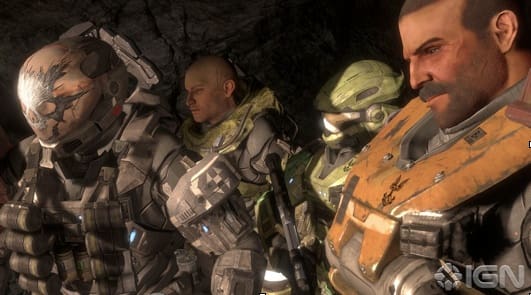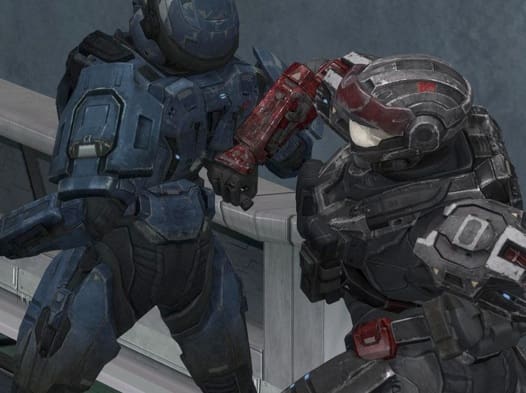On November 15th, 2001, Bungie changed American culture forever with the release of Halo 1 (Halo: Combat Evolved to those who played it). Those white, teenage/young adult males who drink Monsters all night and don’t wake up until 5:00 PM? Yeah, that’s Halo’s fault. The success of the Xbox as a platform? Also directly attributable to Halo. And, as with all things successful, it is necessary to make more . . .
Except Halo 2 and Halo 3 were actually very good games, unlike most sequels, and deserved the awards and sales records they earned. As one who has spent countless hours in the Master Chief’s cybernetic helmet, however, I was understandably nervous about Bungie’s latest escapade into the Halo universe: their most recent foray into the Halo universe without the Chief (Halo: ODST) was a bit of a flop.
The most noticeable change from the campaign in recent Halo titles: not only are the Elites again your primary enemy, they are scary again. They have stopped speaking English, as per the original, and are much bigger than they used to be. Other than the Brutes (more on them later), the Elites are the biggest threat on the battlefield. They are the ones you want to take out first.
The rest isn’t just cleanup, though; even the Grunts (who have also stopped speaking English) are (slightly) more difficult to fight than they used to be. They have taken cues from the Jihadists, suicide bombing more often than they used to, and occasionally blowing up on you after they die.
They are also not nearly as easy to scare away as they used to be. The Jackals are also much more difficult, and come in more varieties. The Hunters, too, are even more difficult than they were in Halo 1. All these add up to make the most difficult campaign in a Halo game ever.
I do, however, take exception to the Brutes. To be perfectly honest, I was never really a fan of the Brutes to begin with, and they seem oddly placed and forced into the game. Even weirder is that the only weapons they brought with them were the Gravity Hammer, the Spiker, and the Mauler, two of the three of which have been rendered useless with the removal of dual wielding. The iconic Brute Shot has been removed.
With the Elites as enemies in the game, and their expanded arsenal, the Brutes seem unnecessary and redundant components in combat.
Perhaps the most dangerous and potentially uncomfortable change is the transition from the Master Chief to the unnamed and enigmatic “Noble 6.” Those worried can breathe easy, because Noble 6 is every inch the cybernetic slayer that the Chief was. Never is this more apparent than in the new assassination (melee kill from behind) animation: you mount your enemy’s back and stab him in one of a few randomized ways.
There is nothing more satisfying than taking a small two second break and watching your avatar jump on your buddy’s back and taking him out. One word of caution: you can’t just tap the melee button, you have to smash it with gusto to trigger the special assassination animation. It also takes a second longer, and you risk someone else stealing your kill even while you are on your enemy’s back.
Not only that, but Noble 6 is completely customizable, which has been expanded beyond anything the Halo franchise has yet offered. You also take your customization with you into all game modes, including campaign.
You create Noble 6 from the ground up: gender, color, looks, and loadouts (see below), and you feel enough of an attachment that the ending, while not completely cry-worthy (although some people have), leaves you feeling like you just got punched in the gut. No spoilers, though. Suffice to say, Bungie pulled out all the stops for this game, while keeping it easy to understand.
Nowhere but Firefight gamemode is it so clear that Halo: ODST was a sandbox for the Halo team to work out new features. For those unfamiliar with the gamemode, Firefight is essentially a game of endurance. How long can you (and a couple of buddies) hold out against an unending and increasingly difficult horde of alien invaders?
The major update from ODST is that human players can now play both sides of the fence: as long as one player is a human, others can take control of Elites and assist the bots in crushing the human race. The Elites had better watch out though, because if a human nabs them, their death adds extra lives to the human’s limited stock. This one innovation takes this style of play from just more bots to a heated competition between you and your friends (or random people, whichever floats your boat).
It is, however, primarily in the weapons that Halo: Reach reaches back to its Combat Evolved roots. No longer are they unerringly accurate, sometimes just bad luck will steal a kill from you. And, sometimes worse luck will get you killed. And, most importantly, the pistol is back, scope and all.
I could write pages on just this one topic, but I’m extraordinarily relieved that they restored the Magnum to its former glory. There is also strong innovation and expansion in the alien arsenal, breaking the mold that Halo: 1 set, which has hardly been changed at all. The DMR (Designated Marksman Rifle) is also a huge improvement over the Battle Rifle from Halos 2 and 3, because as a single shot weapon (vs. 3 round burst), it is both longer ranged and requires more accuracy.
I’m also going to go out on a limb here and say that the removal of dual wielding was a good thing. I was never really a fan, and that feature always seemed redundant to me.
A conspicuous and controversial change was the addition of loadouts and armor abilities. You have built-in powerups to your Spartan armor, some based off the little balls scattered around in Halo: 3 that you threw at people like grenades but had unique properties, like bubble shields and radar jamming. Some are entirely new, though, like (the long overdue) sprinting, a hologram, (a la “Holoduke” from Duke Nukem 3D) and the highly controversial jetpack.
Personally, I found the jetpack well balanced, because if you are using the jetpack, there are a lot of other good options that you aren’t using. Overall, I feel that these features are a good addition to the game, are well balanced, and add variety and spontenaiety to the gameplay.
My verdict? This is Bungie’s magnum opus. It takes the best features from all the Halo games, eliminates what didn’t work, and created a game for the ages. It channels the spirit of the original Halo, but it brings a lot of innovation and improvements from the last decade or so. It certainly challenges the modern FPS on many fronts, and is an enjoyable and lasting experience.





